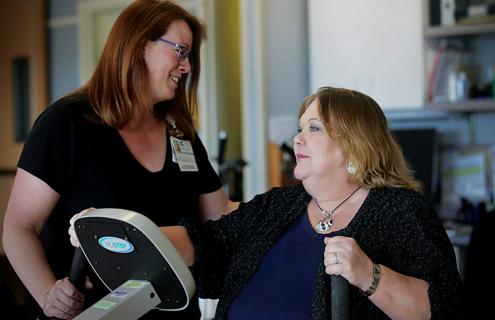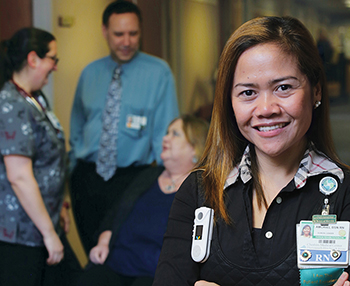
Every member of Cheshire’s rehabilitation staff is passionate about delivering quality care with the goal to return each of their patients to their highest possible level of function and independence. And in Cheshire’s inpatient unit, that commitment can be seen from day one, as the care team begins working with patients and their families to develop a coordinated plan of care-with the goal of utilizing each patient’s individual strengths and abilities to achieve an optimal level of independence.
As the only comprehensive acute inpatient physical rehabilitation unit in Southwestern New Hampshire, it provides highly specialized care close to home for patients in the Monadnock Region. That personalized rehabilitation care is provided in a safe, supportive, and nurturing environment that offers the advantage of being located in a hospital setting.
Cheshire’s outpatient rehabilitation department provides services for adults and children with physical and/or developmental disabilities causing functional limitations including mobility, self-care, communication, and swallowing deficits. From cardiac and pulmonary rehabilitation, to sports medicine and industrial rehabilitation, these professionals work with patients and physicians to provide the right services and treatment plan to meet each individual’s rehabilitation goals.
For Claire Simpson, a recent visit back to the inpatient unit where she received rehabilitation care, brought smiles and hugs as Claire was greeted by many of the staff who had worked closely with her to regain her strength and mobility to return home. Here’s her story.
It started in September with pain, then weakness, in her hips.
“I thought it was a pinched nerve, but it got so bad that I went to the emergency room at my local hospital in Springfield, Vermont,” says Claire Simpson, 63. “They referred me to Dartmouth-Hitchcock Medical Center.”
Initially hospitalized for nine days, Simpson was eventually diagnosed with acute motor axonal neuropathy, a variant of Guillain-Barre syndrome. Guillain-Barre is a disorder in which the body’s immune system attacks the peripheral nerves. Weakness and tingling in the extremities are usually the first symptoms and they can quickly spread, eventually paralyzing the entire body. Simpson was experiencing such pain and weakness in her legs and arms that she couldn’t walk, and needed assistance to transfer from her hospital bed to a wheelchair, and to carry out the activities of daily living such as bathing and dressing.
While there’s no cure for the various forms of Guillain-Barre syndrome, a treatment called plasmapheresis can speed recovery and reduce the condition’s severity. Simpson began undergoing this treatment at Dartmouth-Hitchcock; it involved removing the liquid part of her blood (plasma) and separating it from her blood cells. The blood cells were then put back in her body, which would manufacture more plasma to make up for what was removed. Plasmapheresis works by ridding plasma of antibodies that fuel the immune system’s attack on the peripheral nerves.
Rehabilitation therapy is another key component of recovery, so Simpson was referred to Cheshire Medical Center’s acute inpatient rehabilitation facility. It provides a higher level of care than a skilled nursing facility in that patients must be able to tolerate at least three hours of therapy a day, they are seen by a physician every day, and there is around-the-clock nursing care by registered nurses (RNs).
Our best moments are when we can return patients to their homes. Some of our patients come here with no expectations of being able to go home and they and their families are elated with their progress and ability to manage on their own. That’s a success for us and our patients.
John Ditri, MD, Medical Director of Rehabilitation
“When Claire first came to us, she was quadriparetic—she had muscle weakness affecting her arms and legs and was confined to a wheelchair,” explains physiatrist John A. Ditri, MD, a board-certified specialist in physical medicine and rehabilitation. “She also had some involvement of her face, which affected her speech and ability to eat and swallow.
“Our aim was to get her functionally independent, maximize her neurological recovery, and prevent secondary medical problems,” he adds.
Simpson puts it this way: “I wanted to get walking again. And come home.”
She began physical therapy, occupational therapy, and speech-swallowing therapy with Cheshire’s team of skilled professionals. Her first few weeks weren’t easy, however. She was readmitted to Dartmouth-Hitchcock twice because her condition worsened. And each time she returned to Cheshire, it was like starting over with her rehabilitation therapy.
“But once they got her plasma treatment figured out, she started making slow but steady neurological gains,” Dr. Ditri says, noting that she underwent weekly, then biweekly plasmapheresis treatments, traveling by ambulance from Keene to Lebanon each time.
“Everyone was so positive and very encouraging,” Simpson says of her Farnum team. “The process of therapy is so intimate, everyone became like family.”

“Tricia (Patricia Toomey, PT) was my physical therapist, and she had a knack of knowing how far to push me without going over and making me feel discouraged,” she relates.“Each session left me on a high note.”
“Cindi (Cindi Zipoli, OT) was my occupational therapist, and she was amazing, getting me back into the real world, able to dress and bathe myself,” she continues.
“And all my nurses were great, keeping my spirits up,” she adds.
“You couldn’t keep Claire down,” says Terry Hebert, RN, CRRN, who was Simpson’s primary nurse during her stay. “She had a couple of setbacks while here, but it didn’t stop her from giving 110 percent every day. She never quit.”
Farnum Rehabilitation teams consist of the following roles:
The patient and family are considered the most important members of the rehabilitation team.
Physiatrists evaluate and treat rehabilitation patients. They are medical doctors trained in the specialty of Physical Medicine and Rehabilitation and are responsible for designing and coordinating comprehensive, patient-centered treatment plans with other team members.
The Rehabilitation Registered Nurse specializes in rehabilitative care and assists the patient in achieving maximum independence. The focus is on medical care, prevention of complications, and patient and family education.
The Physical Therapist helps restore function for patients with problems related to movement, muscle strength, exercise, joint function balance, and coordination.
The Occupational Therapist helps restore function for patients with problems related to activities of daily living through the therapeutic use of functional activities.
The Speech Therapist helps restore function for patients with problems related to cognitive, communication, and swallowing issues.
The Recreation Therapist coordinates therapeutic recreation programs to help promote social skills and leisure activities.
The Social Worker acts as a liaison for the patient, family, and rehabilitation treatment team. The social worker helps provide support and coordinate discharge planning and referrals.
The Behavioral Health Team supports the emotional needs of patients and families through the process of treatment, and helps address issues such as depression and adjustment to disability.
Another member of her care team was social worker Lois Kitz, LICSW.
“My focus is on family support—although we all overlap a lot—and discharge planning,” she says.“We set an initial discharge date within a few days of admission and put it on the calendar. And then the entire team meets every week to see if that’s still achievable.”
These team meetings are a hallmark of the highly coordinated multidisciplinary care Cheshire provides.
“We meet at the patient’s bedside once a week, and include family or friends at the patient’s request,” Kitz explains. “We update everyone involved on how things are going, and identify any areas that need more attention.”
“We also can bring in other specialists, when appropriate, to help manage medically complex patients without interrupting their rehabilitation,” Dr. Ditri notes.
“Plus, we have the ability to arrange for behavioral health team visits for psychological support, something Claire took advantage of for a while,” Kitz says.
“This unit really sees each patient as an individual and in a holistic way, and we’re able to tailor care to their unique needs,” she continues. “We feel privileged to be invited into their lives to help deal with this crisis that’s occurred, and brighten the horizon for them. It’s an upbeat, encouraging place,” she adds.
Family is an integral part of the care team, too.
“Claire’s husband Derek was here every day,” Kitz says. “He was very much her advocate and was willing to do a lot for her, including dealing with the insurance company. We told him he didn’t have to take that on, but he felt it was something he could do.”
“I felt included, and that my concerns were heard as well,” Derek says. “And I felt confident in what they were doing for Claire. They’re so in tune with what’s going on and your needs.”
This sense of teamwork extends beyond the walls of the center and into the community, ensuring that each patient has the necessary services in place for a seamless and successful transition from Cheshire to home. During her 27-year tenure at Farnum, Kitz has forged important partnerships with these vital resources.
“I’m on a first-name basis with virtually all the home healthcare, outpatient rehab, local nursing homes, and community service organizations not just here in Keene but throughout the region,” Kitz says.
Simpson was discharged to home on January 12, four months after her first emergency room visit. In rehab parlance, she was “contact guard assist,” which meant she only needed someone close by to help steady her when she performed functional tasks. She was using a walker, and could go up and down stairs.
To sustain her hard-won progress, Simpson initially did outpatient occupational therapy twice a week in Claremont, near her home, then “graduated” to physical therapy twice a week. When we spoke in mid-February, she was able to walk independently, relying on the wheelchair only when she went out or got tired.
“With her outpatient therapy, she will continue to improve,” Dr. Ditri notes.
“People come to us having suffered something that’s often sudden and life-changing—things like spinal cord injuries, head injuries, brain tumors, strokes, conditions like Claire’s—and their world is turned upside down,” Kitz says. “We offer them a lot of compassion along with excellent medical care to help them become more independent.”
Simpson and her husband are believers.
“We absolutely felt that the people at Farnum were partners in my care,” Simpson says. “We were right to put our trust in them. They do an absolutely amazing job.”